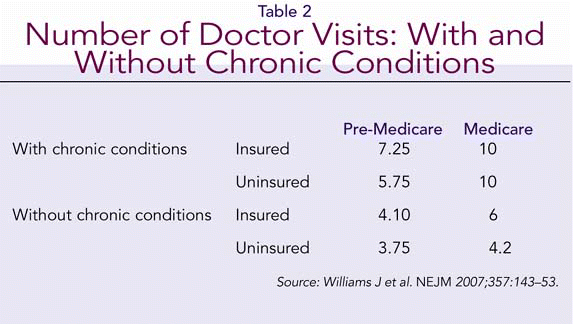The relationship between visiting a doctor and having insurance may also be subtler than the study suggests (see Table 2).
Explore This Issue
November 2007Costs and Coordination
In contrast to the NEJM study’s authors, Dr. Levine believes that the cost of having insurance would not be offset by savings down the road. It’s all about the laws of supply and demand, he said. There’s a big jump in usage [at age 65] for both groups. It’s as if you were on a restricted diet and suddenly someone said you could eat as much as you want. There’s pent-up demand, and the uninsured will consume health care services when they get insurance. Suddenly, they can see lots of doctors-and they will. By implication, insuring more people without adding a more coherent delivery system will only drive up cost.
Matthew Narrett, MD, Catonsville, MD-based Erickson Retirement Communities Senior Vice President and Chief Medical Officer, added, Once a $100 office visit becomes available at an 80 percent discount through insurance for a $20 copay, people visit the doctor a lot more than if they were paying what it actually cost.
Erickson Retirement Communities, with 50 physicians and 20 nurse practitioners on 18 campuses and with its own Medicare Advantage plan, has a model that balances supply and demand for services for Medicare beneficiaries. For example, Erickson physicians routinely see many ENT conditions. Chronic sinus infection, bronchitis, hoarseness, throat polyps, tinnitus, and vertigo are treated in our on-site offices. Conditions that are untreated and allowed to worsen require surgery and other expensive intervention. It’s true that an ounce of prevention is worth a pound of cure, said Dr. Narrett.
Through its HMO model Erickson has reduced hospital and nursing home length of stay by 35% and 50%, respectively. Aligning its incentives, Erickson patients get 50% to 100% more office visits than average Medicare beneficiaries, using prevention to help ward off negative outcomes.
How to Pay?
Adding 30 million or so 50-to-64-year-olds to the Medicare rolls, as the NEJM study suggests, would sink an already distressed system. The trustees of the Social Security and Medicare trust funds state in their 2007 annual report (www.ssa.gov/OACT/TRSUM ) that the financial condition of the Social Security and Medicare programs remains problematic; we believe their currently projected long run growth rates are not sustainable under current financing arrangements.…Medicare’s Hospital Insurance (HI) Trust is already expected to pay out more in hospital benefits this year than it receives in taxes and other dedicated revenues. The trustees issued a ‘Medicare funding warning’ for the first time in 2007, saying, The longer we wait to address these challenges, the more limited will be the options available, the greater will be the required adjustments, and the more severe the potential for detrimental economic impact on our nation.

Leave a Reply